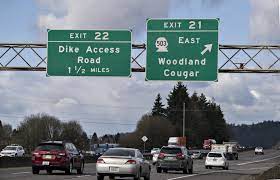After five years spent in a preliminary phase, Woodland’s Exit 21 improvement project is currently moving toward its next step to alleviate traffic at the busy interchange.
Woodland’s City Council approved hiring the engineering firm, Kittleson and Associates, to design and assist in the construction management for the project in August last year. The city received $2.6 million from Cowlitz County for the project’s development. Kittleson and Associates has begun the second phase of the improvement project to complete a project-ready design and receive permitting by the end of 2026.
In a March 4 meeting, Engineer Anthony Yi told the City Council the key concerns about the interchange identified during the preliminary engineering phase. He said, during the weekday afternoon rush hour, traffic backs up at the northbound Interstate 5 off-ramp. State Route 503, particularly between Lake Shore Drive and Millard Avenue, also experiences heavy congestion, causing drivers to wait through multiple traffic signal cycles, he said. As a result, traffic that has accumulated on Goerig Street, especially on the Buckeye Street/Lakeshore Drive intersection, creates delays.
Kittleson and Associates began its research for the project in 2019. It conducted a traffic study, created several concepts and hosted an open house for community members. The study resulted in two alternatives for the interchange. One concept focuses on reducing traffic through roundabouts, while the other proposes improved traffic signals to reduce traffic congestion.
Consultant Caleb Cox told the City Council that the new phase of the project is expected to be complete by the end of 2026.
“The goal of phase two is to get the design fully engineered to a point where it can be ready to construct,” Cox said.
Yi said that the team aims to refine the concept and document the project by September of this year. Afterward, the group will communicate with the Washington State Department of Transportation (WSDOT) and the Woodland council to determine which of the two proposed alternatives is more viable.
Council member Douglas Freimarck asked if the two concepts presented by Kittleson and Associates could accommodate increased traffic from future commercial zoning within city limits.
“Considering we’re going to have a thousand-plus heavy commercial trucks, and anywhere between 200 or 500 vehicles coming from a new development … we anticipate several increases in traffic,” Freimarck said, adding he doubted that the interchange improvement would accommodate the more than 20 percent increase in traffic flow expected.
Yi explained that the team’s analysis and increased traffic flow simulation indicates either alternative will resolve the interchange’s problems for at least 20 years.
“We wouldn’t be here if we didn’t feel strongly that those are still two very good, viable options for the community,” Yi said.



